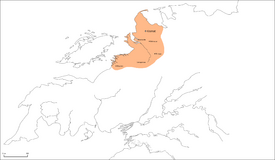Jhanda Empire
Jhanda Empire Jhanda Saamraajy (Matrabashi) | |||||||||||
|---|---|---|---|---|---|---|---|---|---|---|---|
| 430–800 | |||||||||||
| Motto: झंडा आगे ले जाना (jhanda aage le jaana) Carrying forward the flag | |||||||||||
 The Jhanda Empire between 745-759 CE | |||||||||||
| Status | Extinct | ||||||||||
| Capital | Kismat | ||||||||||
| Capital-in-exile | Kinadica | ||||||||||
| Common languages | Matrabasha | ||||||||||
| Religion | Ashram | ||||||||||
| Demonym(s) | Jhandan | ||||||||||
| Government | Absolute Monarchy | ||||||||||
| Samrat | |||||||||||
• First | Rajaram I | ||||||||||
• Last | Prashant II | ||||||||||
| Legislature | Shahee Parishad | ||||||||||
| Historical era | Jhanda Era | ||||||||||
• Established | 430 | ||||||||||
• Tauma-Jhanda conflict begins | 680 | ||||||||||
• Southern Expansion | 730 | ||||||||||
• Start of the Adhenata Kayud | 759 | ||||||||||
• Fall of Kismat | 800 | ||||||||||
| |||||||||||
| Today part of | |||||||||||
The Jhanda Empire was an ancient rajyani historical power in north Satria which existed from 430 to 802 CE. At its peak, between the 7th and 9th centuries, it covered most of modern-Rajyaghar. The Empire was a centralised power with the capital of Kismat being the political, economic and religious capital of the Empire. Along its periphery, the Empire exerted its influence by offering protection to smaller states and cities in return for taxes.
Founded by the Dynasty to which the Empire is named after, the Jhanda Empire's most notable rulers include its founder, Rajaram I, and its last Emperor, Prashant II. During Samrat Rajaram I's rule, the Empire rapidly expanded to dominate the Naratha river basin, conquering numerous city-states and minor kingdoms which had been isolated following the Bahulsantulan. From the early 6th to 680 CE, the borders of the Empire would remain relatively unchanged, focusing on internal development and exerting its influence over northern satria. In the late 7th Century, the Tauma began to encroach on the borders of the Empire, resulting in a 50 year period of constant conflict between the two powers. The Empire would rapidly expand southward following the collapse of the Tauma. The over-extension of the Empire in a short period of time exhausted the army and weakened the state. By the mid 700s, the Sangma had reached the periphery of the Empire and following a series of skirmishes, engaged the Jhanda Empire in the Adhenata Kayud. The war would savage the Empire's heartlands and in 800, the capital of Kismat was looted by the Sangma forces. Following the escape of Samrat Prashant II to Kinadica, the Empire signed a treaty of suzerainty and would collapse into multiple smaller states under the Sangma two years later.
Under the Jhanda Empire, internal trade between the cities flourished, agriculture thrived and exapnded and the once independent and isolated settlements were connected through a single system of taxation, administration and security. The Empire would establish the first major road network across its lands and even extending into its satellite city-states and territories. Much of this internal development was started to help fund the Empire's expansion but would later serve to solidify the Dynasty's control over its territories. The Jhanda Era is now widely accepted to be a period of re-development following the Bahulsantulan, with the matrabahsi language flourishing, the ashram faith developing and spreading and the rights of women increasing. However, it also saw a period of great subjugation for minority communities and repression of non-ashram faiths and increased tensions.


